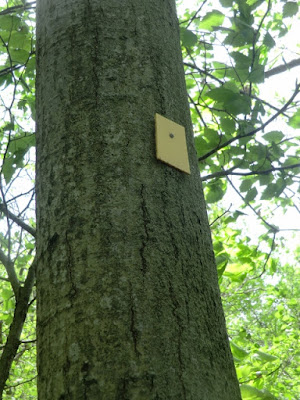We also encountered some less than friendly species of plants and animals. The first site, especially, was swarming with mosquitoes. They were everywhere, making that distinctive whining noise. To me, it sounds almost unnatural, like a horror movie sound effect. At both sites, there were ticks. So we had to be careful.
Not all animals and insects are evil, scary creatures. We observed a few animals and we also observed signs of animals. These include tadpoles in Gun Creek, a swallowtail butterfly, woodchuck, and deer. There were many birds. Diane is able to recognize birds by their songs. She heard songs from: pilliated woodpecker, great crested flycatcher, Baltimore oriole, chickadee, wood duck, red eye vireo, and catbirds.
The picture above depicts a plant nemesis. Remember the old adage, "Leaves of three, leave it be"? See the plant above and the sets of three leaves. Yep. You've got it. Poison ivy. Look, but don't touch. If you accidentally touch the poison ivy, here is a website that you can go to where you can find ways of handling the website. Click the next word: word. |















4 comments:
I grew up with a forest as my playground. Loved seeing your beautiful photos! Made me very nostalgic. Visiting on the Road Trip.
When you return in fall, it will be interesting to see the contrasting flora. The spring was beautiful. So much to see on woodland walk.
I learned several new things from your walk in the woods: conservation easement, photo stations, and tree stands. Quite interesting! The two of you reminded me of a series I've been watching on Neflix: Rosemary and Thyme, a show about gardener/detectives who always stumble across a dead body while fixing up old English gardens :)
@ShonnaSlayton from
Shonna Slayton YA Writer - Blogged the 1940’s from A to Z and now on the road trip
I love to take walks in the woods and snapping pictures of nature. Thanks for sharing!
Write with Fey
Post a Comment